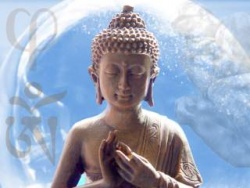Vāsanā
Vāsanā (Sanskrit; Devanagari: वासना) is a behavioural tendency or karmic imprint which influences the present behavior of a person.
It is a technical term in Dharmic Traditions, particularly Buddhist Philosophy and Advaita Vedanta.
Nomenclature, orthography and etymology
Vāsanā (Devanagari: वासना, Tibetan: བག་ཆགས, Wylie: bag chags) and it's near homonym vasana (Devanagari: वसन) are from the same Indo-European linguistic root, sharing a common theme of 'dwelling' or 'abiding'.
- Vāsanā (Devanagari: वासना):
- Past impressions, impressions formed, the present consciousness of past (life) perceptions;
- The impression of anything in the mind, the present consciousness formed from past perceptions, knowledge derived from memory, the impressions remaining in the mind;
- Vasana (Devanagari: वसन): cloth, clothes, dress, garment, apparel, attire, dwelling or abiding.
Buddhism
- See also:Saṅkhāra
Keown (2004) defines the term generally within Buddhism as follows:
- "vāsanā (Skt.). Habitual tendencies or dispositions, a term, often used synonymously with Bīja (‘seed’). It is found in Pāli and early Sanskrit sources but comes to prominence with the Yogācāra, for whom it denotes the latent energy resulting from actions which are thought to become ‘imprinted’ in the subject's storehouse-consciousness (ālaya-Vijñāna). The accumulation of these habitual tendencies is believed to predispose one to particular patterns of behaviour in the future."
Sandvik (2007: unpaginated) states that:
- ... bag chags, in Sanskrit vāsanā. This word is used a lot in presentations about Karma. It means habitual tendencies, subtle inclinations that are imprinted in the mind, like a stain. For example, if someone smokes, there will be a habitual tendency for an urge to smoke every day, usually around the same time. There are bigger picture bag chags, such as why some people are kind by nature, and others are cruel; it's the tendency to behave in a certain way that will trigger similar actions in future, reinforcing the bag chags.
Cheng Weishi Lun
Lusthaus states that the Cheng Weishi Lun (Chinese: 成唯識論), a commentary on Vasubandhu's Triṃśikā-vijñaptimātratā, lists three types of vāsanā, which are synonymous with 'Bija' or 'seeds':
- Vāsanā of 'names and words' or 'terms and words (Chinese: ming-yen hsi-chi'i) which equates to 'latent linguistic conditioning'. These seeds, planted in the 'root consciousness' (Sanskrit: Alaya-vijnana) by 'terms and words' are the 'causes' (Sanskrit: hetu) and 'conditions'
(Sanskrit: pratyaya) of each 'conditioned or caused element or phenomena' (Sanskrit: samskrita Dharma).
There are two forms:
- 'Terms and words indicating a referent' (Chinese: piao-yi ming yen) through which a Mindstream is able to express (Chinese: ch'uan) meanings (yi, artha, referent) by differentiation of vocal sounds (Chinese: yin-sheng ch'a-pieh); and
- 'Terms and words revealing perceptual-fields' (Chinese: hsien-ching ming wen), through which a Mindstream discerns (Sanskrit: vijnapti, upalabdhi) perceptual-fields (Sanskrit: visaya) as ' phenomena of mind' (Sanskrit: Citta Dharma; caitta dharmas).
- Vasanas of self-attachment (Sanskrit: atma-graha-vasana; Chinese: wo-chih hsi-ch'i) denoting the false attachment to the seeds of 'me' and 'mine'.
- Vasanas which link streams-of-being (Sanskrit:bhavanga-vasana; Chinese: yu-chih hsi-ch'i) denoting the karmic seeds, 'differently maturing (Sanskrit: Vipaka) that carry over (Chinese: chao) from one stream-of-being to another in the Three Worlds (Sanskrit: Triloka).
The bhavanga (linkage from one stream-of-being to the next) is of two types:
- Contaminated yet advantageous (Sanskrit: sasrava-kusala; Chinese: yu-lou shan) that is actions (Sanskrit: Karma) which produce desirable (Chinese: k'e-ai) fruits; and
Bon & Dzogchen
Bag chags are important in Bonpo soteriology, especially the view of the Bonpo Dzogchenpa, where it is fundamentally related to the key doctrines of 'Primordial Purity' (Tibetan: ཡེ་ནས་ཀ་དག, Wylie: ye nas ka dag As Karmay relates in his English rendering of the Bonpo text 'Kunzi Zalshay Selwai Gronma' (Tibetan: ཀུན་གཞི་ཞལ་ཤེས་གསལ་བའི་སྒྲོན་མ, Wylie: kun gzhi zhal shes gsal ba'i sgron ma) from the Tibetan:
- "Some people doubt that if kun gzhi is pure from the beginning, it cannot be accepted as the ground on which one accumulates one's impressions (bag chags), but if it is the ground for storing the bag chags, it cannot be pure from the beginning.
- The essence of kun gzhi at no time has ever experienced being defiled by the bag chags since it is absolutely pure from the beginning. In that case, one might think that it cannot be the 'ground' for storing the bag chags.
However, the bag chags are stored there only through the 'co-ordination' of all the eight kinds of consciousness. Kun gzhi is therefore merely the ground for storing the bag chags. It is like a treasury.
- Although in the sphere of space, many a world came into existence and remains, the essence of space remains undefiled by the dirt of the world, even a particle of it.
Hinduism
Śrīmad Bhāgavatam (5.11.5) (also known as the Bhagavata purana), a principal text for the Vaishnava tradition of Sanatana Dharma employs the term 'vasana':
A satisfactory English rendering has not yet been sourced, but the import is that the 'imprinted-volitions-of-mind' (vāsanātmā), whether pious or impious, are conditioned by the Gunas.
The gunas propel the mind into different 'formations' (Rūpa-bhedam).
The 'mind' (atma) is the master of the sixteen material elements.
Its 'refined or coarse quality' (antaḥ-bahiṣṭvam) determines the mind-formations of manifestation (tanoti).
Advaita Vedanta
A vasana literally means 'wishing' or 'desiring', but is used in Advaita in the sense of the sub-conscious or latent tendencies in one’s nature.
Writing from an Advaita Vedanta perspective, Waite refers to a model offered by Edward de Bono:
- If you take a jelly, solidified and turned out onto a plate, and you trickle very hot water onto the top, it will run off onto the plate and leave behind a faint channel where the hot water melted the jelly. If you now pour more hot water, it will tend to run into the same channels as before, since these offer the line of least resistance, and deepen the channels. If this is done repeatedly, very deep channels will form and it will become difficult, if not impossible, to get the water to run anywhere else. The equivalent of an entrenched habit has been formed.

